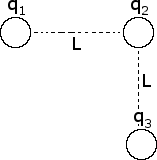Gauss's Law Examples
A uniformly charged sphere has a radius of 40 cm and a total charge of 80 nC spread throughout its volume. If the following sections were removed from the sphere, how much charge would they contain?
A. A Spherical section with a radius of 10 cm
B. A cubical section with sides of 5.0 cm
C. A cylindrical section with radius 8.0 cm and length 15 cm
Related Problems
Two metal spheres are charged, q = 6Q and q = -2Q, and are separated by a distance d. The attractive force between these two spheres is 20 N. The metal spheres are then brought together so they are touching, and then separated again a distance d. What is the new charge on the metal spheres and what is the new force between them?
Two objects, whose charges are +3 nC and -2 nC, are separated by 1.0 mm. Find the magnitude of the attractive force that either charge exerts on the other.
In the figure below, L = 1.0 mm, q = +3 nC, q = -2 nC, and q is +4 nC. Find the magnitude and direction of the net electrostatic force on q

A very long cylindrical insulator with a radius of 30 cm has a volumetric charge density of -80 . What is the volume of the electric field a distance of 10 cm away from the center? 30 cm from the center? 50 cm from the center?